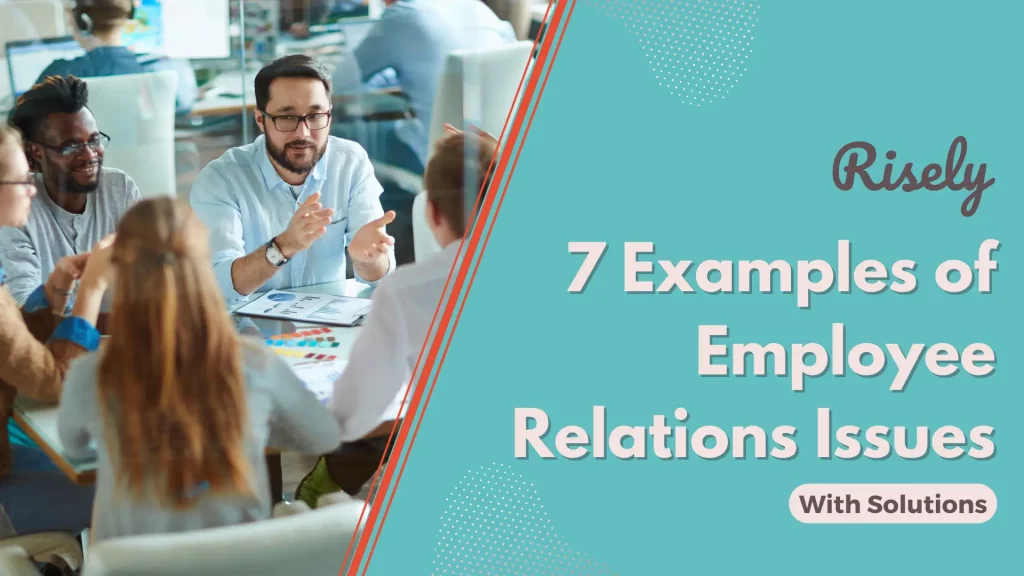Good employee relations are essential for a healthy and productive work environment. However, even the best-managed organizations can face employee relations issues from time to time. These issues can range from conflicts between employees to serious safety concerns in the workplace. As an HR manager or employee relations manager, it’s essential to have a solid understanding of handling these situations when they arise.
This blog post will review seven common employee relations issues and provide practical tips on taking them effectively. We’ll also discuss the critical elements of a valuable framework for resolving employee relations issues and the essential skills required for managing them. So, whether you’re a seasoned HR professional or just starting, this post will help you continually improve employee relations in your organization.
Understanding Employee Relations
Developing good employee relations is crucial to fostering a positive work environment. It involves addressing common issues such as misunderstandings and gossip, promoting open communication and inclusion, and ensuring transparency. By implementing best practices for effective employee relations, HR professionals can create an environment where employees feel valued and supported. Employee relations managers are a critical actor in this area. Employee relations managers ensure that the concerns of the team members are heard and resolved promptly. Their job calls for an active approach that provides a seamless workplace experience to everyone. Hence, there are a number of issues that they have to deal with. While the details can vary, we have created a list of common employee relations issues to understand their impact and share potential solutions.Common Employee Relations Issues and How to Handle Them
Addressing workplace conflicts promptly and fairly is essential for maintaining good employee relations. Ensuring equal pay and preventing discrimination is crucial to fostering a positive work environment. Implementing effective onboarding and training programs can help employees feel supported and engaged. It is essential to promote employee engagement through regular communication and recognition to prevent disengagement in your team. Additionally, handling absenteeism and attendance issues appropriately can help maintain productivity and accountability within the team. Managers can create a happy workplace and contribute to the company’s overall success by addressing these common employee relations issues.Conflict Management
Promptly and objectively addressing conflicts is critical to effective conflict management. Encouraging open communication and active listening helps parties express their views and concerns. Mediating discussions allows for the exploration of mutually beneficial solutions. Conflict resolution techniques like negotiation or compromise can help find common ground. Providing training and resources ensures employees have the tools to prevent future conflicts. By implementing these strategies, relations managers can create a harmonious work environment, improving morale and contributing to the company’s overall success.
- Scenario: Two team members, Sarah and John, are in a conflict over a project’s direction. They disagree on the approach, and this has caused tension.
- Impact: The conflict disrupts teamwork, hampers productivity, and creates a negative atmosphere.
Pay Disputes and Wage Issues
Ensuring fair and timely payment is crucial for employee satisfaction and retention. Communication and transparency can effectively address pay discrepancies. Regular audits and reviews of wage policies ensure compliance with labor laws. Implementing a clear and transparent pay structure minimizes disputes. Seeking legal guidance resolves complex wage-related issues. Incorporating these strategies into your employee benefits framework will create a happy and productive workplace.
- Scenario: An employee, Alex, believes their pay is unfairly low compared to colleagues with similar roles.
- Impact: Low morale, reduced motivation, and potential talent loss.
Safety Concerns in the Workplace
Providing a secure work environment is crucial for employee well-being and productivity. Regular safety inspections and risk assessments can help identify potential hazards, ensuring the safety of employees. Implementing employee training and awareness programs promotes a culture of safety, encouraging everyone to prioritize their well-being. It is essential to promptly address safety concerns and take corrective actions to maintain employee trust and loyalty. Establishing a reporting system creates an open and transparent environment, enabling employees to raise safety issues without fear of retaliation.
- Scenario: Employees in a manufacturing plant report both physical safety issues (e.g., faulty equipment) and psychological concerns (e.g., stress due to tight deadlines).
- Impact: Workplace injuries, reduced morale, and decreased productivity.
Managing Annual Leave Disputes
A transparent leave policy promotes consistency and fairness among employees, ensuring everyone understands the guidelines. Encouraging advance notice and proper documentation simplifies leave management, minimizing disputes. Self-service timekeeping software empowers employees to track their annual leave, enhancing transparency. Regular communication and reminders about leave policies are proactive measures to reduce misunderstandings. Additionally, planning for peak vacation periods in advance can help avoid conflicts and disruptions within the team. Maintaining open dialogue and adhering to a well-established leave policy is crucial to effectively managing annual leave disputes.
- Scenario: An employee requests time off for a family emergency, but the manager denies the request due to workload concerns.
- Impact: Employee dissatisfaction, potential burnout, and decreased team morale.
Timekeeping and Attendance Problems
Accurate timekeeping is crucial for operations and fair payroll processing. Implementing a time-tracking system enables managers to monitor attendance and identify patterns of absenteeism. By providing clear expectations and consequences for attendance issues, employers promote accountability among their workforce. Additionally, flexible work arrangements can improve employee work-life balance and reduce absenteeism. Regular communication and feedback on attendance expectations foster a culture of responsibility within the organization. These measures contribute to better time management, increased productivity, and overall success in employee relations.
- Scenario: An employee, Sam, frequently arrives late and takes extended breaks.
- Impact: Disruption to team productivity, resentment, and increased workload on others.
Performance Issues
Regular performance evaluations are an excellent way to identify areas for improvement and recognize achievements. Providing constructive feedback and coaching can help employees overcome performance challenges. Setting clear performance expectations and goals improves employee motivation and engagement and enables them to understand what is expected of them. Offering training and development opportunities enhances employee skills and overall performance. Additionally, documenting performance issues and implementing performance improvement plans can effectively address persistent problems and ensure your company’s success.
- Scenario: An employee, Lisa, consistently fails to meet targets.
- Impact: Reduced team morale, potential impact on overall performance, and stress for Lisa.
Dealing with Unresolved Conflicts
To promote a positive work environment, it is important to encourage open communication and active listening. Employers can effectively address employee disputes by implementing mediation and conflict resolution techniques. A formal grievance policy provides a structured approach to resolving conflicts. Additionally, identifying the root causes of conflicts can help prevent their recurrence in the future. In complex situations, involving a neutral third party can facilitate resolution. Creating an atmosphere of understanding and collaboration is essential for resolving unresolved conflicts.
- Scenario: Employees Sarah and Mark have ongoing conflicts that disrupt their team’s dynamics.
- Impact: Decreased team cohesion, reduced productivity, and potential talent loss.
Workplace Bullying and Discrimination
Promoting a safe and inclusive workplace is crucial in employee relations. Having a zero-tolerance policy for bullying and discrimination creates a supportive environment. Regular anti-bullying and diversity training sessions raise awareness and educate employees. Addressing complaints demonstrates a commitment to employee well-being. Implementing clear reporting procedures empowers employees to report incidents without fear of retaliation. Encouraging bystander intervention and support networks helps combat bullying and discrimination.
- Scenario: An employee, Jamie, experiences bullying behavior from a colleague.
- Impact: Psychological distress, decreased morale, and potential legal consequences.
Other Interesting Reads
Developing a Framework for Resolving Employee Relations Issues
Establishing a framework is essential to address employee relations issues effectively. This framework should include critical elements such as clear communication and conflict management. Flexibility is also vital in resolving these problems, as it allows for adaptability to changing needs. Developing policies and procedures that are fair and unbiased is another crucial aspect of the framework. Regularly reviewing and improving this framework ensures that it effectively addresses employee relations issues. By implementing a well-designed framework, managers can navigate common employee relations issues and contribute to the company’s overall success.Key Elements of an Effective Employee Relations Issues Framework
A practical framework for employee relations relies on several key elements.- First, there must be a clear understanding of company policies and procedures, ensuring everyone knows their rights and responsibilities.
- Consistent enforcement of rules and regulations is essential to maintain a fair and equal work environment.
- Encouraging open and honest communication fosters trust and transparency within the organization.
- Fair and unbiased conflict resolution procedures should be in place to address any issues that may arise.
- Finally, continuous improvement based on feedback and evaluation helps to ensure that the framework remains effective and adaptable.
The Importance of Flexibility in Employee Relations Framework
Flexibility plays a crucial role in the employee relations framework. It allows customized solutions to address individual needs and concerns, considering different personalities and cultural differences. Moreover, flexibility enables managers to respond effectively to changing security and safety requirements, staying updated with evolving employment laws and regulations. By being adaptable and flexible, employee relations managers can create a harmonious work environment that promotes morale and employee retention. This commitment to flexibility is an excellent way for them to ensure the success of their company and foster a happy workplace.Essential Skills for Managing Employee Relations
To successfully manage employee relations, several essential skills are crucial.- Effective communication is vital in fostering understanding and trust between employers and employees.
- Conflict resolution skills are necessary for addressing disputes and maintaining a harmonious work environment.
- Empathy and understanding help create a supportive atmosphere where employees feel valued.
- Strong problem-solving abilities are essential for handling various issues that may arise.
- Active listening promotes open dialogue and encourages employees to share their concerns.
Conclusion
In conclusion, a proactive approach to employee relations is crucial for maintaining a positive work environment. Organizations can foster a culture of trust and respect by addressing conflicts promptly and fairly, resolving pay disputes, ensuring workplace safety, and effectively managing performance issues. HR managers play a vital role in creating and implementing a framework for resolving employee relations issues. Developing essential skills such as active listening, conflict resolution, and empathy is critical to effectively managing employee relations. Organizations can create a harmonious workplace where employees feel valued and supported by continually improving employee relations.Communication is the key to effectively managing relationships. Test your skills now.
Take the free communication skills assessment by Risely today to ensure that common mistakes do not create troubles for you.






